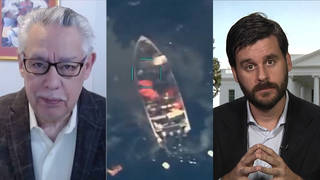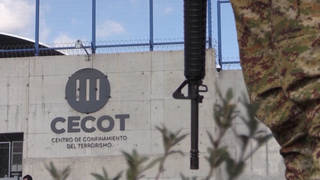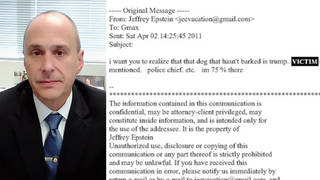
We speak with Liz McIntyre, author of “Spychips: How Major Corporations and Government Plan to Track your Every Move with RFID” that examines radio frequency identification–a technology that uses tiny computer chips to track items at distance. Major corporations are working right now to install RFIDs on all consumer products. What about in you arm? Or in your kids? We also speak with freelance journalist Annalee Newitz who recently had an RFID implanted in her arm. [includes rush transcript]
“Imagine a world of no more privacy.
“Where your every purchase is monitored and recorded in a database, and your every belonging is numbered. Where someone many states away or perhaps in another country has a record of everything you have ever bought, of everything you have ever owned, of every item of clothing in your closet — every pair of shoes. What’s more, these items can even be tracked remotely.
“Once your every possession is recorded in a database and can be tracked, you can also be tracked and monitored remotely through the things you wear, carry and interact with every day.
“We may be standing on the brink of that terrifying world if global corporations and government agencies have their way. It’s the world that Wal-Mart, Target, Gillette, Procter & Gamble, Kraft, IBM, and even the United States Postal Service want to usher in within the next ten years.
“It’s the world of radio frequency identification.
“Radio frequency identification, RFID for short, is a technology that uses tiny computer chips — some smaller than a grain of sand — to track items at distance. If the master planners have their way, every object — from shoes to cars — will carry one of these tiny computer chips that can be used to spy on you without your knowledge or consent.”
Those are the opening words of the book, “Spychips: How Major Corporations and Government Plan to Track your Every Move with RFID.” Today we are joined by one of the co-authors of “Spychips”–Liz McIntyre.
- Liz McIntyre, a consumer privacy expert and author of “Spychips: How Major Corporations and Government Plan to Track your Every Move with RFID.” She serves as the Communications Director for CASPIAN (Consumers Against Supermarket Privacy Invasion and Numbering), a grass-roots organization that has been tackling consumer privacy issues since 1999. She also writes about consumer issues as the MoneyMom, a syndicated family money writer and columnist.
- Website: Spychips.com - Annalee Newitz, freelance journalist. She writes about the intersection of technology science and culture and is a contributing editor at Wired Magazine. She recently had an RFID implanted in her arm.
- Website: Techsploitation.com
Transcript
AMY GOODMAN: We welcome you to Democracy Now!
LIZ MCINTYRE: Hi, Amy. How are you?
AMY GOODMAN: It is good to have you with us.
LIZ MCINTYRE: Thank you.
AMY GOODMAN: Why don’t you tell us about what spy chips are?
LIZ MCINTYRE: Well, as you said, radio frequency identification, or RFID and they are very tiny computer chips. Some of these are smaller than a grain of sand, and they are connected to miniature antennas. The combination is called an RFID tag. Now each of these chips has a unique identification number. It is sort of like a Social Security Number for things in that the plan is that no other item would have a chip with the same number on it. Big companies you named like Procter and Gamble and Wal-Mart want one of these tags on every manufactured product on planet earth, and of course, there’s a company called Verichip that would like one of these RFID devices in everyone’s flesh.
AMY GOODMAN: Now, who is pushing this?
LIZ MCINTYRE: Well, right now the 800-pound gorilla of RFID in retail is Wal-Mart. Procter and Gamble is another big player. Basically any major company you can think of is very interested in the technology. Of course, also our own government is starting to put RFID tags in U.S. Passports this year. And we are concerned they may also try to use this in other ways. Already they are experimenting with the technology with the U.S. Visit program attaching RFID tags to visitor documents, and of course, recently, we revealed that we found an R.F.I., a Request for Information, that shows the Department of Homeland Security is looking for beefed up RFID that could be read from up to 25 feet away, that can be read in cars speeding by. So, potentially, a visitor who has an RFID tag on a document could be scanned without his knowledge or consent as he drives by. Of course, you know, RFID works with electromagnetic radio waves, sort of like the radio waves you listen to your favorite FM program on, your radio program, and they travel in space through solid objects like purses, backpacks, wallets, and these tags, while they are passive — there’s no battery — any time they are within range of a reader device, this unique number can be scanned and you would never know it.
AMY GOODMAN: We are also joined on the telephone by freelance journalist Annalee Newitz. She writes about the intersection of technology, science and culture, a contributing editor at Wired magazine. She’s redefining 'embedded journalist.' She just had an RFID embedded in her arm. Welcome to Democracy Now!
ANNALEE NEWITZ: Hi.
AMY GOODMAN: It is good to have you with us. Can you explain what you did?
ANNALEE NEWITZ: Sure. So I had been researching an article for Wired about security issues and RFID’s, and I read some publicity materials from Verichip in which the company claimed that its chip was — couldn’t be counterfeited, so it was the perfect anti-theft key because, you know, the implication was that no one could steal your keys without actually cutting off your arm — although they didn’t actually say that in the advertising materials. So that sounded very curious to me because I hadn’t heard of any RFID’s that were completely secure like that so I decided to find out if it was true. A very nice doctor at UCLA agreed to implant me with one of them, very quick operation, and then I visited with an RFID expert named Jonathan Westhughes who has a little Ipod-sized device that he made himself, a quite cheap homemade thing, and it is designed to clone RFID chips which means make a duplicate copy of them basically. And in about 10 minutes, we sat down in a restaurant, crowded place, and he was able to duplicate the signal from my RFID, which meant that if my RFID had been used to open vaults or locks, he would have been able to duplicate that signal simply by basically bumping into me with his device and then going ahead and using what he picked up from it to open up a door.
AMY GOODMAN: Can you back up a minute, Annalee. Describe the operation. The — getting the implant, you mean?
AMY GOODMAN: Yes.
ANNALEE NEWITZ: So — basically, the RFID is quite small. It’s just a Microchip attached to a very tiny antenna, and it’s imbedded in doped glass, that’s a surgical glass, that’s safe. It is just like the tags that you put into your pet or into your cow if you are a farmer. And they take a needle, a hollow needle, and basically just shoot the chip under your skin.
AMY GOODMAN: Do you still have this implant?
ANNALEE NEWITZ: I do, yes. Unfortunately, as it turns out, they are somewhat difficult to remove because they are so small that, although it is easy to put them in, the surgeon explained to me you kind of have to dig around a little bit to find it, to remove it. So, so far, yeah, I have kept it in.
AMY GOODMAN: Do you set off any alarms with it?
ANNALEE NEWITZ: No. You don’t. Actually, the read range on these, the range that you need to be — You need to be quite close to them to read them. So you really have to be within a couple of centimeters. So it isn’t going to set off anything particularly.
AMY GOODMAN: Liz McIntyre. Have you found that people who have these chips embedded in them might set off something, either in an airport or a drugstore, a metal detector?
LIZ MCINTYRE: I haven’t heard any reports of that, no. In fact, there are very few people that have even gotten one of these things, been crazy enough to do it. So, you know, we don’t have a lot of feedback on what the ultimate effects of this will be.
AMY GOODMAN: I understand that in New Orleans, they are putting these in corpses. Is that true?
LIZ MCINTYRE: Yes, after Hurricane Katrina, the coroner’s office met with Verichip, and of course, Verichip was interested in promoting their technology, and they thought this was a great opportunity. It was like the vultures circling after the tragedy, and they swooped in with their Verichip equipment and had the coroners implant these chips into the remains of the victims and also into the remains of some of the deceased that had been washed up from their graves.
AMY GOODMAN: I wanted the read to you from a piece in the Guardian, the headline is, “Girl to Get Tracker Implant to Ease Parents’ Fears.” It says, “The parents of an 11-year-old girl are to take the extraordinary step of having her fitted with a microchip so that her movements can be traced if she’s abducted. Danielle Duvall will have the device implanted in her arm in the next few months. The scientist assisting the plan claimed the miniature chip will apparently send a signal via a mobile phone network to a computer which will be able to pinpoint her location on an electronic map.” That was a piece written a few years ago. Liz McIntyre, is this a trend?
LIZ MCINTYRE: Actually, I spoke with a Verichip people about this. They actually are talking about at some point having people report back to some home station through the Verichip and some kind of a telephone system. They are very excited about the idea of parolees perhaps reporting to parole officers remotely through a combination of an implanted chip and a telephone of some kind. So, yes, I understand that that is possible. I wonder how that little girl feels being uniquely numbered and tracked.
AMY GOODMAN: The Food and Drug Administration has approved putting these chips in children?
LIZ MCINTYRE: Well, they approved the chip as a medical device. Now, you should understand that that does not mean that they did extensive testing on it. They simply made recommendations about when kinds of things companies with these microchip implants should do to make sure they are somewhat safe. We have yet to see some evidence from the Verichip Corporation on things like tests run on people who have gone through MRI’s. In fact, their literature that they hand to patients, the fine print on the back, they make them basically sign away their lives saying that the Verichip may not be merchantable or fit for the purpose, saying that the database linking their information may not be available at some point, that the chip may not be readable at some point in areas where there are ambient radio waves. So, you know, the device right now is just — it is pretty much, as Annalee said, pretty much worthless as a security device, has questionable value as a medical device when linked to medical records, and as a security, tracking kind of a thing, it is just — I just don’t understand why anybody would want such a faulty, invasive process — procedure.
AMY GOODMAN: We have to break. When we come back, I want to ask you about chipping as a way for advertisers to target their consumers better. We are talking to Liz McIntyre, consumer privacy expert. She is co-author of Spy Chips: How Major Corporations and Government Plan to Track Your Every Move with RFID, also Annalee Newitz, who writes for Wired and had a chip implanted in her. Stay with us.
AMY GOODMAN: Let’s turn to a clip of the young woman who was at a technology fair talking about the implanting of this chip.
WOMAN: They were putting in the numbing into my hand. I passed out, and I have never passed out before, so it was quite shocking when I was waking up and I had no idea where I was. They hadn’t even put the chip in yet, so I had to lie down and kind of like regain consciousness and think about where I was and what I was doing, all of that.
AMY GOODMAN: That is one person’s experience getting this chip put into their hand. Liz McIntyre, how well known is this becoming? Are doctors actually doing this?
LIZ MCINTYRE: Yes, there are some doctors. In fact, at the Verichip website you can find them. They are in several states across the country. It is being sold to them to increase their revenue for their practices, of all things. It is being pushed a lot to doctors that deal with geriatric patients because they feel like there will be a big market there. So, yeah, we are seeing more on the Verichip front although only about 70 people so far have been implanted. Of course, what you were just talking about are people who we call 'do-it-yourself implanters,' people who are putting little chips between the webbing, in the webbing between their thumbs and their pointer fingers, and this is being done by people — not very many, just kind of 20 and 30 tech types who want a cutting-edge way to, say, open their front doors, access their computer systems, that kind of thing. Many of these chips that they are using are hobbyist’s chips you can buy for under $3. They may not even be sterilized. Our concern here is they are setting an example for young people, sort of breaking down a mental barrier to getting uniquely numbered, and of course, the precursor to being monitored and tracked in society. And the other thing is that, you know, they are getting them to stick these devices in themselves like piercings almost, and I can see where some high school kids might think this is really cool and not consider they could do serious damage to their hands. There could be infection that could result from it. And just the fact that making a part of your body a key to any kind of a valuable asset could be asking for some serious trouble.
AMY GOODMAN: You have a chapter in your book, Liz McIntyre, called “Adapt or Die: How RFID backers hope to get you onboard.” What do you mean? Adapt or die?
LIZ MCINTYRE: Well, it is actually the title of the book that was given out a conference held where heads of major companies were invited back a couple of years ago. I mean, it sounds shocking but true, and that’s really the attitude they have. Companies like Wal-Mart are telling their suppliers, you know, either get on board or we are just not going the deal with you anymore. Right now, they are forcing their top suppliers to tag at the pallet and case level, but of course, their ultimate goal is to tag and track every manufactured product at some point, even packs of gum.
AMY GOODMAN: How would advertisers track their products if the chip isn’t embedded in the individual but in the product?
LIZ MCINTYRE: Well, by association, things you wear and carry could reveal who you are. This is really illustrated by an I.B.M. patent application we illustrate in our book Spy Chips. It’s a patent application called “Identification and Tracking of Persons using RFID Tagged Items.” Subtle, huh Amy? And in there they talk about the day when every product will have an RFID tag and then when people pay for the items at checkout, the unique number on that chip would be linked to that person, you know, if they pay by something other than anonymous cash, by some credit card or check card. Then later when those tags are seen in the environment by reader devices, the number can be gleaned and the exact identity of the person or something about the person can be known, and they talk about, for example, if you have a baby bottle in your purse that’s identified, they might flash you an ad for diapers. Which, you know, it would steam most customers to know that someone has plans to spam them with additional advertising. But then I.B.M. goes on to talk about how the government could use this technology and track people in public places with a device they call the 'Person Tracking Unit.' They actually call it that, and they talk about the places to watch people. They say airports, train stations, bus stations, museums, sports arenas, libraries, elevators and even restrooms.
AMY GOODMAN: We are talking to Liz McIntyre. She’s the co-author of Spy Chips: How Major Corporations and Government Plan to Track Your Every Move with RFID. You talk trash, how these tags that you throw away say as much as the ones you keep.
LIZ MCINTYRE: Right. Well, of course the line that the retailers and manufacturers are giving consumers is, 'Well, you don't need to worry about this. You know, just throw them away when you get home.’ But, of course, there are plans for our trash in the RFID world, too. Nothing, in fact, will escape the gaze of the RFID world if master planners like Wal-Mart, Procter and Gamble and so on have their way. We have found a patent application by Bell South — in fact, a couple of them, and they are the ones that own Cingular Wireless, of course, talking about the day when everything has an RFID tag and, you know, there is a log of everything from the time it is manufactured to the time it is thrown away. In fact, at the dump they want to have large conveyor devices look through every piece of trash with picker arms, siphon the tag numbers from the items that have been thrown away, and update a database to give a complete history of an item. And, of course, they talk about selling this information to marketers who could then know how long, say, something is kept in someone’s pantry, perhaps where items are transported. So, yeah, even your trash will talk if we don’t stop it.
AMY GOODMAN: How does the government use Radio Frequency ID, RFID’s?
LIZ MCINTYRE: Well, of course already they are starting to put them in our passports, and they are using them, of course, in the U.S. Visit program. We mentioned that earlier, and they are looking for, of course, super beefed up RFID now, with super capabilities, and in this RFI I mentioned earlier, they are talking about, you know, this super technology not just for the Department of Homeland Security, but they’re talking about other federal agencies. We are very concerned because of the Real ID Act passed last spring that they will consider putting RFID tags in our driver’s licenses. As you know, that act gave the Department of Homeland Security the right to set federal driver license standards so that every state would have to have certain information in driver’s licenses they issue. Now, people are calling that already a de facto national I.D. because you cannot function in modern society without a driver’s license. I mean, you can’t even get on an airplane, so imagine if they put RFID tags in these and it becomes a remotely readable national I.D. that someone from Homeland Security or another federal agency could simply scan, as you drive by at 55 miles an hour or as you walk down the street.
AMY GOODMAN: Liz McIntyre, you talk about a nightmare scenario, and you ask, “What if Hitler had RFID?”
LIZ MCINTYRE: Right.
AMY GOODMAN: Explain.
LIZ MCINTYRE: Well, we believe that if Hitler had RFID, he would certainly have used it to his advantage. He would have probably tagged all of the Jews and tagged all of their possessions. It is interesting that Hitler actually reached out to the cutting-edge technology of the time which was the punch card system. They hired I.B.M., the people we just talked about who have this patent application for identification and tracking of persons using RFID tagged items. They reached out to I.B.M., and I.B.M. leased Hitler the technology that allowed him to track every Jew and every possession, and you can bet if he had access to this patent application and this ability, he would use it.
AMY GOODMAN: You are saying, “Pull the plug.” What kind of movement is developing right now in response to these chips, whether implanted in human beings or in products?
LIZ MCINTYRE: People are very upset about it when they learn about it. Of course, the major companies have been trying to keep this under wraps. The plan was to kind of slip it in and tell people, 'Oh it is just an improved bar code' to limit any kind of alarm. Their own studies show 2/3 of people they surveyed were very upset with RFID on privacy grounds once they understood what it was and what was coming. So when we say, “Pull the plug,” we say that people need to be educated about what’s coming, and our book, of course, hopefully will go a long way to that. We also have a website. It’s SpyChips.com.. We have a free news letter and pictures of some of these devices we are talking about today, and up-to-date information, but in addition to educating people ourselves, we need the grassroots people out there to tell their neighbors, their friends, tell them what’s coming, of course, read our book, and pass along our website information. And then we need to also shop responsibly. We believe that free market can do a great deal. In fact, we are relying on the free market to help control this kind of invasive technology. Stop shopping at Wal-Mart. I mean, there are plenty of other reasons to stop shopping at Wal-Mart. Tell them why. Say, “You know, if you are acting irresponsibly, then we are not going to send our dollars your way.” Vote with your pocketbook. Don’t buy things from Procter and Gamble, a company that is really promoting this technology. I mean, they are the makers of many major products. We are talking Tide laundry detergent, Cascade dishwashing detergent. Pantene shampoo, Gillette is another big offender, with their Mach III razor blades. They ran a trial that was very invasive in England not too long ago.
AMY GOODMAN: What do you mean, very invasive?
LIZ MCINTYRE: Well, there have been several already, although RFID isn’t everywhere yet, there have been several cases in which it has been used to spy on people. In a store called Tesco in the U.K., sort of like our Wal-Mart, Gillette rigged what they called a 'smart shelf' in that store, and each of the packages of Mach III razor blades on the shelf had an RFID tag in it. The shelf had the technology, the reader device to know when someone picked up one of the packages. When that happened, a camera took a close-up mug shot of the shopper without his knowledge or consent, and then later at checkout another close-up mug shot was taken. At end of the day, the picture at the shelf and at checkout were compared, and if there weren’t matching photos, then they assumed the person was a shoplifter, and they would follow that person closely the next time. Now never mind that the person had, you know, their mother-in-law pay for the blades or they abandoned them in the magazine rack. That’s what happened, and of course, the Guardian newspaper helped us break that story, and people were all up in arms. That shelf disappeared pretty quickly.
AMY GOODMAN: Pharmacies, how would they be using RFID’s?
LIZ MCINTYRE: Well, pharmacies. The F.D.A. is very interested in this technology. They want to track drugs from the time they are manufactured all the way to the time they are sold to consumers. Our position is, you know: 'Use the technology in your warehouses.' We are not going to fight that. We will let the labor unions worry about all those electromagnetic radio waves that could cause health issues. That’s another matter, but we say, you know, once that prescription is dispensed to a consumer, there should be no tag on that container. A consumer should not have to worry about his medical privacy, wonder if someone is scanning his pharmacy bag or scanning his wallet or wherever else he’s carrying a prescription to get information about what he might be taking or even use that number to track him. In fact, we just issued a statement, a join statement, with EPIC, the Electronic Privacy Information Center, and we sent that to the F.D.A. the other day when they requested comments, and were — both of us are joining and saying, “No to RFID tags on the packages, consumers take home from pharmacies!”
AMY GOODMAN: Well, Liz McIntyre, I want to thank you very much for being with us.












Media Options